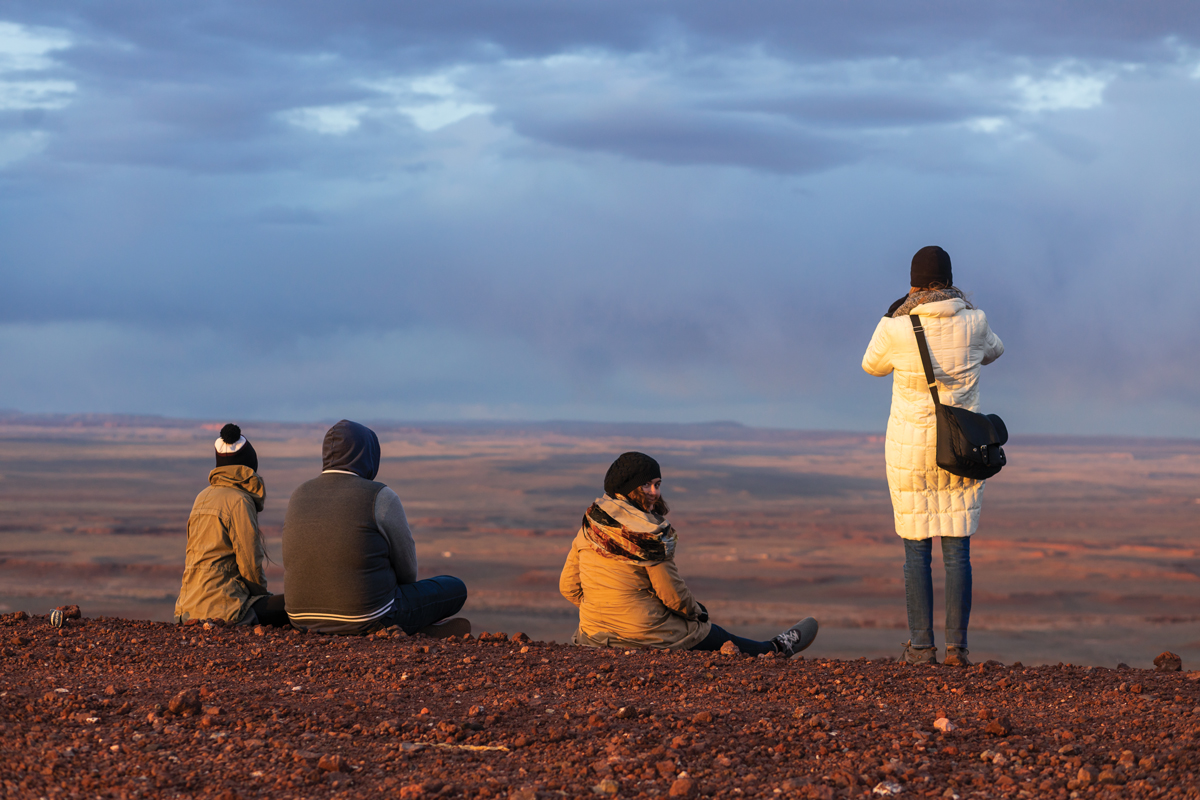[ad_1]
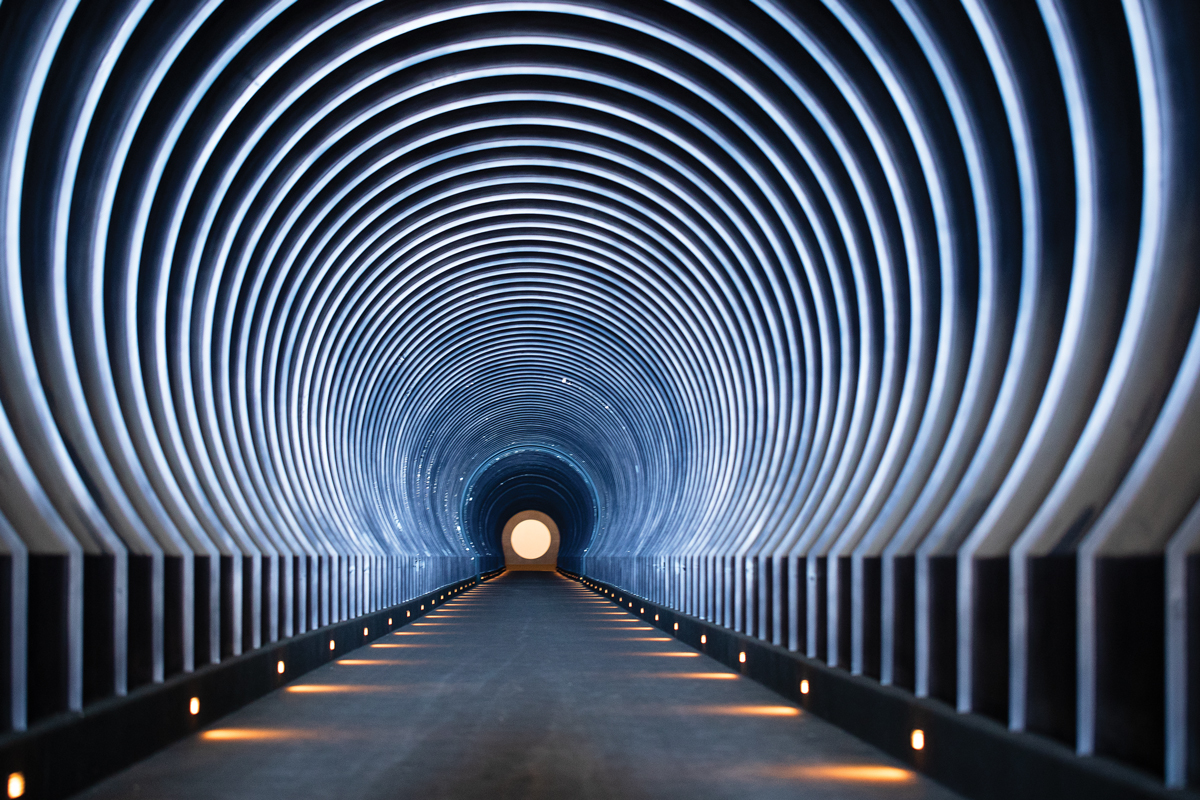
The Alpha (East) Tunnel of James Turrell’s Roden Crater.
KLAUS OBERMAN/COURTESY ASU
When James Turrell flew the skies of Arizona in 1974, not yet acquainted with the volcano that would soon become his life’s work, he piloted his tiny plane over the nearby sites of Sunset Crater and Wupatki National Monument. The former is a hulking cinder cone that built up after dramatic eruptions around the turn of the first millennium, when lava spewed forth in red and yellow hues said to have inspired its name. The latter was home to settlements of ancient indigenous peoples known as the Sinagua—so described for their ability to live “without water”—whose desert descendants today include Hopi and Navajo natives.
Had he flown an hour or so south, to Tempe, Turrell would have seen an array of buildings that make up Arizona State University. That would have been before the development of the gleaming new School of Earth and Space Exploration and the Center for Science and the Imagination, institutions of a kind that has made ASU a hub for innovation and interdisciplinary thought. It would have predated the construction of Air Apparent, a sculptural observatory that Turrell designed to encourage students on campus to commune with the sky. And it would have been much longer still—some four-and-a-half decades—before Turrell and ASU would enter into a momentous partnership to aid in the completion of perhaps the grandest artwork ever conceived: Roden Crater.
The extinct volcano in an otherworldly area flanked by forestland, and the Painted Desert has commanded much of the 76-year-old artist’s attention over time. When he first laid eyes on it in his early 30s, he was flying over locations now being considered for a visitor’s center and lodging for legions of art pilgrims eager to experience an artwork that few have seen. Practical necessities like roadways and rest stops require serious engineering in environs so remote, and then there is the matter of money: at least $200 million needed to ramp up construction so as to open Roden Crater to the public in a projected five years.
[See the Table of Contents for the Summer 2019 edition of ARTnews: “Reshaping the American Museum.”]
The partnership forged with the university last year makes all that more feasible, thanks to a fateful meeting at the Crater between Turrell and Michael Govan, president of the artist’s Skystone Foundation (as well as director of the Los Angeles County Museum of Art), along with ASU president Michael Crow and Steven Tepper, dean of the university’s Herberger Institute for Design and the Arts. Assembled together in an immersive observatory still in the midst of creation, the group hatched a plan to engage Roden Crater from different perspectives. “James said, ‘What are your ideas for how the university might support and connect with this work?’ ” recalled Tepper, who at ASU leads the nation’s largest comprehensive design and arts school at a research university. “We went back and started thinking about all the powerful ways that Roden Crater could serve the university, and how the university had a unique set of assets that could benefit the Crater and help it live in the world once it is completed.”
Crow, for his part, has been celebrated in the annals of higher education for transforming ASU from a party school to a future-minded interdisciplinary institution that U.S. News & World Report has named the most innovative university in the country for the past four years. With a student body of some 110,000 in an assembly of schools strategically aligned to merge science and the humanities with other realms of study, Crow commands considerable potential to help Turrell turn Roden Crater from a nomadic private enterprise into an accessible public destination ready to greet the world. He also has access to fund-raising channels beyond those tuned most expressly to the arts.
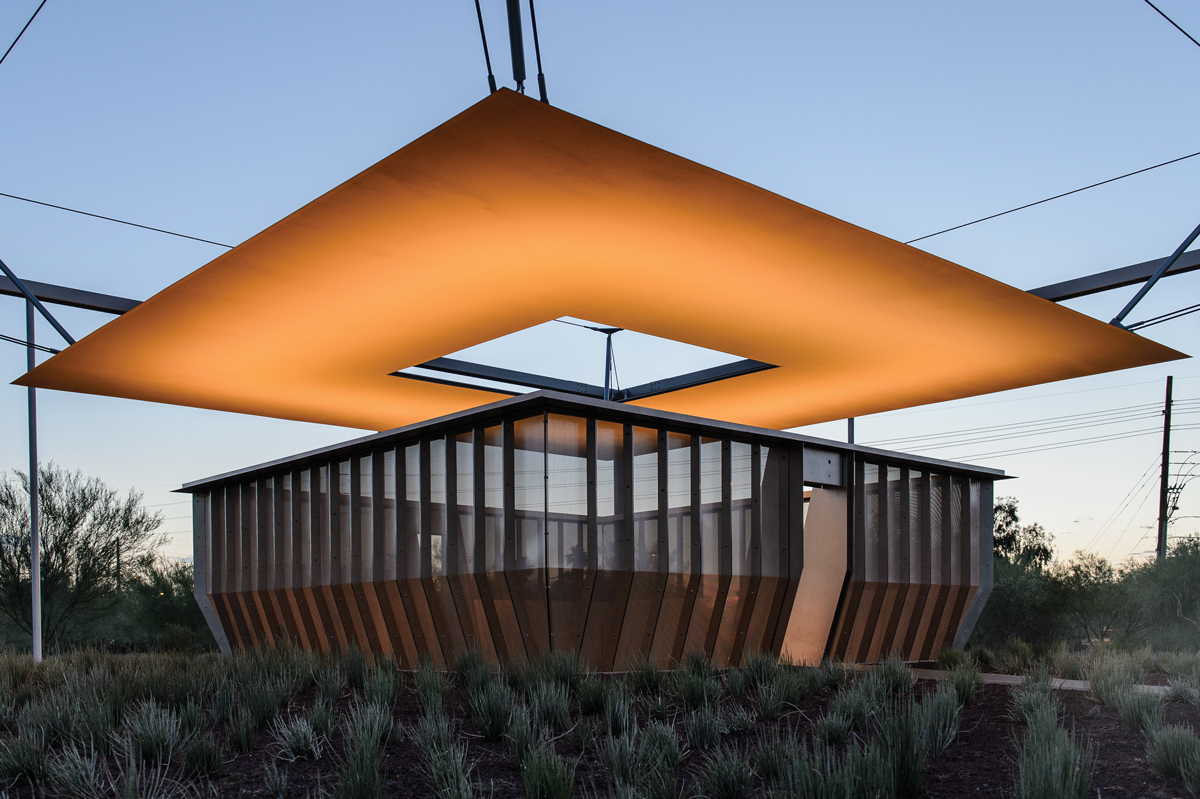
James Turrell, Air Apparent, at Arizona State University.
ANDY DELISLE/©ARIZONA BOARD OF REGENTS, ALL RIGHTS RESERVED/COURTESY ASU
As an artwork that encompasses a sprawling landmass as well as decades’ worth of crafting to customize it as a man-made offering to the cosmos, Roden Crater may be “an order of magnitude too great” for conventional means of art-world funding, said Govan—whereas, “when a university comes in, they have particle accelerators. They see what Roden Crater is as an element of the university, and it makes sense, even by scale.”
He cited another example: “People give gifts of hundreds of millions of dollars to hospitals that are part of universities—teaching hospitals that are there as much to educate as to be part of the health system.” Roden Crater can work in a similar manner, Govan said, as evidenced by a university curriculum already underway with ASU field labs devoted to engaging Turrell’s work in classes like “Art and Sensory Acuity,” “Volcanic Arts & Sciences,” “Light and the Imagination,” and “Indigenous Stories and Sky Science.”
Students from a variety of disciplines enrolled in the first class last fall and others that followed this spring, with aspiring artists joined by peers studying architecture, engineering, environmental design, sustainability, geology, astrophysics, American Indian studies, and more. The mix of interests aligns with the practice of Turrell, who early in his career delved into perceptual psychology, optics, mathematics, and astronomy in the service of his art. The interdisciplinary approach also makes sense for a project whose scale—in terms of size as well as time, as Roden Crater has been tuned to astronomical cycles that transpire over thousands of years—raises complex questions.
“We’re in a research and development phase, prototyping a program to understand its potential: what it can be, how to scale it,” said Olga Viso, a former director for the Walker Art Center in Minneapolis and the Hirshhorn Museum and Sculpture Garden in Washington, D.C., who was brought in as a senior adviser on the partnership between Turrell and ASU. “How do you develop a visitor experience? If we build facilities, what will they be like? It’s all in an exploratory phase to figure out what the terms are and to try to raise as much money as we can to accelerate the completion of the Crater.”
“What was clear is that there wasn’t a museum partnership that could handle this,” said Govan, whose work with Turrell began decades before he became the director of LACMA in 2006. “Roden Crater had been sponsored by art collectors and museums very focused on it, but when we build on this scale, it’s supposed to be a museum that you put art inside. The idea that the thing itself is as big as a museum in terms of expenditure is disconcerting to the normal model.”
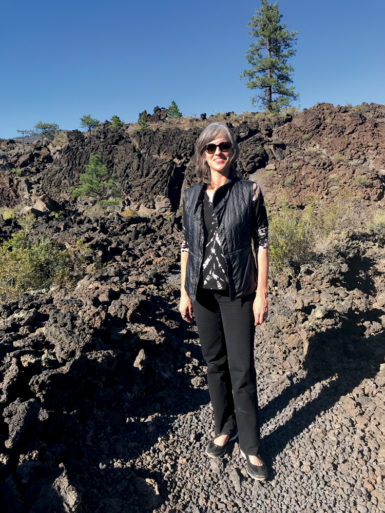
Olga Viso at Sunset Crater.
COURTESY ASU
In the unusual arrangement, Viso sees knowledge to be gleaned by arts institutions seeking to maintain their missions while assessing means of adaptation for the future. After stepping down as director of the Walker in 2017, in the wake of controversy surrounding Sam Durant’s Scaffold—a public sculpture that was dismantled after criticism that it was insensitive in its evocation of a painful episode in Native American history—she has thought a lot about the prospects and constraints that museums face amid changing cultural roles and expectations.
“It’s a difficult moment for all institutions, not just museums,” Viso said. “Society is questioning what institutions mean and stand for. Youth culture doesn’t believe in institutions because they’re staid and part of the status quo.” Few cultural enterprises are as institutional as the university, and Viso finds inspiration in the ways that Arizona State has evolved since Michael Crow took over as president in 2002. Speaking of his transformative time at the school so far, Viso said, “I’m really drawn to what’s happening here with a visionary leader who has challenged base assumptions about an institution and how it’s structured. He’s challenged notions of tenure, put schools together into independent fields, and focused on how a university can impact society and create more intersectional thinking in the future. He had the idea to reinvent what a public university is, and museums need that same reinvention right now.”
Citing a crisis of leadership at many museums across the U.S., Viso said the university model could be instructive. Different forces have shortened the typical tenure of museum directors, moving Viso to write in a recent article in Museum magazine, “What does the face of museum leadership look like in another decade when the average tenure of an art museum director trends more toward 3–5 years rather than 10 years, and there continue to be steady rates of retirement?” She noted that ASU, by contrast, has been able to “recruit people at the forefront of their field and create a platform where they feel energized and have the ability not to fall into institutional traps. They’re given a platform to try something different and evolve. If it’s not working, they just regroup and rethink—and create. Museums sometimes suffer from the need to preserve approaches and strategies instead of thinking to reinvent, restructure, and maybe even abandon certain ways of working.”
The instinct to preserve can hinder museums in different quarters, Viso said. “The institutional structure is in this moment of crisis, toggling between the status quo and the need for change and a realignment of leadership, staff, audience, and boards. That’s what’s out of whack, which is why you’re seeing so much transition.”
One way for institutions to move into the future is by banding together. Recalling her time at the Walker, Viso spoke of acquiring choreographer Merce Cunningham’s archive in partnership with other institutions (including the New York Public Library and the Merce Cunningham Trust) collectively committed to supporting the artist’s long-term legacy plan. “When we were first approached by Merce, his hope was it would all go to one institution,” Viso said. “But one institution can’t really do it effectively.” An adaptable co-op method can make the museum model more amenable, however. “Everything is about owning and the individuality of each museum, but it really [should be] about stewardship,” Viso said. “My generation of directors is much more collaborative than prior generations. Let’s collection-share—why not? Let’s share curatorial expertise across boundaries. Let’s co-own works. Museumgoers don’t care who owns what.”
Museums of different sizes with differing needs would also be wise to consider unconventional partners. “Museums shouldn’t be in the restaurant business or taking on enterprises that are not in their wheelhouse,” Viso said. Mutually beneficial arrangements, however, warrant “exploring partnerships with organizations that aren’t necessarily arts organizations but serve a community in a way that a museum might not have the capacity to but cares about.
“It’s happening more and more—some of it out of necessity, some out of generational shift, some out of opportunity,” Viso said. “Artists like Merce and James are pushing this—artists whose practices are so expansive that they can’t live within one institution. It takes a different approach to legacy and stewardship to think about how to support that. I hope the audacity of ASU taking this on in such a significant institutional way could be inspiring to other organizations and institutions to think of different kinds of partners to advance their support of art and artists and be impactful in their communities. This is one way to ensure relevance.”
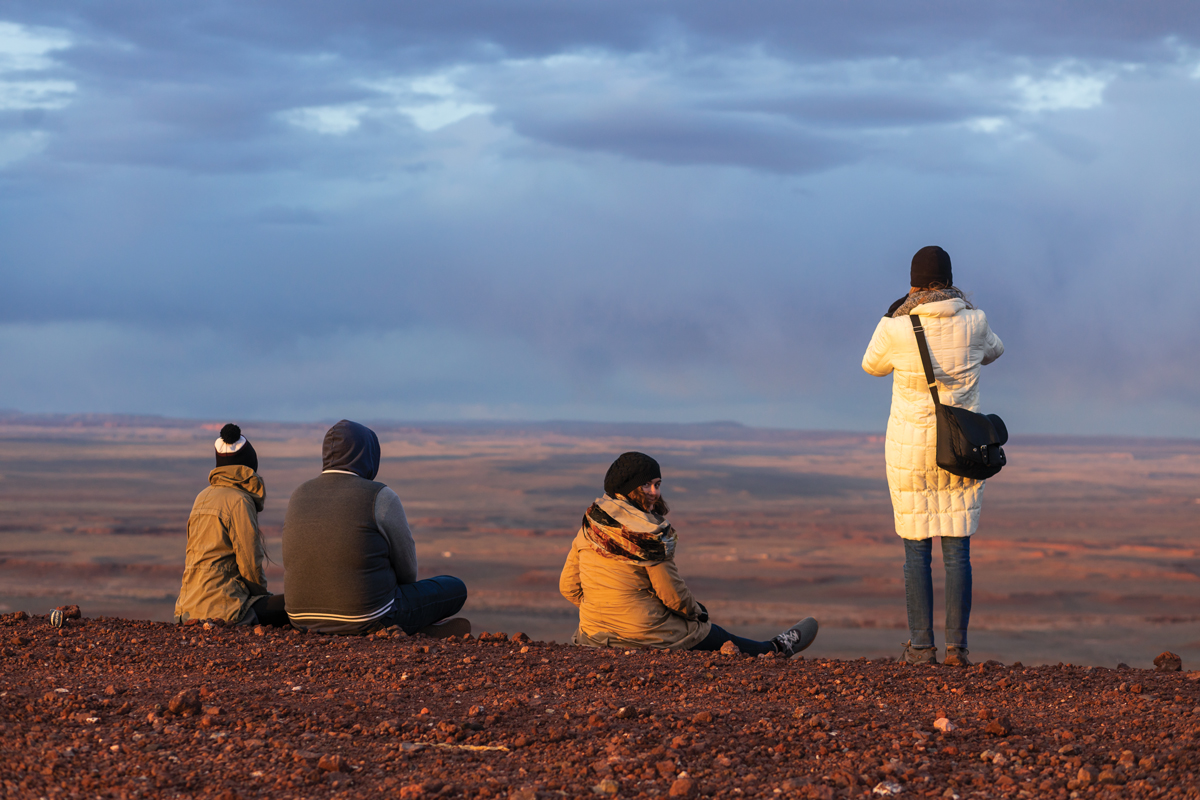
Students overlooking the Northern Arizona landscape from the rim of Roden Crater.
JORDAN NEEL
As Viso spoke during the three-hour drive from Tempe to the area around Roden Crater, views of saguaro cacti—some of them more than 100 years old and weighing several tons—yielded to verdant forest and then to parched desert vistas. The trip has become routine for Viso, who, during the partnership’s enterprise-planning phase, has worked closely with Turrell and the many professors and students who now stake a collective claim on his time.
The same roads past Flagstaff—the closest sizable town, though still an hour away—have recently been traveled by groups of students who have visited not just Roden Crater but significant sights around it in an attempt to understand Turrell’s undertaking as a holistic work of art engaged with its environment and the cultures that have long called it home. For her class “Art and Sensory Acuity,” professor Christine Lee took a caravan of students for a tour of the Crater accompanied by a specialist studying taste and smell in ASU’s School for the Future of Innovation in Society, as well as E. C. Krupp, an astronomer and director of the Griffith Observatory in Los Angeles, who has worked with Turrell since the 1960s. “The Crater is an instrument,” Lee said, “and I wanted the students to feel like they are instruments themselves, with senses they can dial like a microscope that can zoom in and out.” The students’ experience of Turrell and his vision was profound—and potentially influential. “Even though it seems like an unattainable type of piece to make, I keep reminding them that he started out as an art student.”
Wanda Dalla Costa, an architect and professor in ASU’s Design School and the School of Sustainable Engineering and the Built Environment, took her students on a four-day field trip for “Indigenous Stories and Sky Science.” The tour started with a lecture on ages-old communion with the heavens at Navajo Technical University and included stops at significant astronomical sites like New Mexico’s Chaco Canyon, where ancient Pueblo peoples thrived in the centuries between 850 and 1250. “It’s been one of the most profound classes I’ve ever taught,” Dalla Costa said. “It’s a journey the kids went through, not in the classroom but with people in the community, getting out onto the land and hearing stories about sky science, rituals, and everyday life.”
“The experience has been really transformative for me,” said Rhonda Harvey, a Navajo student enrolled in the course while working on her master’s degree in architecture. “I’ve always been interested but have never been able to fully study sky science from an indigenous perspective, and it’s definitely influenced me as a designer to be more holistic in relating to the context of not just the natural landscape of a site but also the sky.”
For his collaborative class with a multimedia artist and professor, Ed Garnero, a seismologist who has not one but two lava lamps in his office in the School of Earth and Space Exploration, engaged a question that had been on his mind: “What would it be like if you took the pithy narrative of a TED talk and the light, motion, and sound from Cirque du Soleil and mashed it up to make fabulous documentaries where people aren’t sure if they just saw a play or were taught something?” Experiencing Roden Crater together with students offered an unusual opportunity to “teach science through emotion,” Garnero said. “The way that artists respond to scientific information is so unbounded by these barriers that we, as scientists, impose on ourselves because we supposedly know what can and can’t be.”
Sherri Wasserman, a Ph.D. student in the class titled “Light and the Imagination,” said she enrolled with excitement when she learned a trip to Roden Crater was part of the syllabus. “I was like, ‘I get to do what?’ ” she said. But the subject took her and her fellow classmates into unexpected territory. “We’re really interested in the political geographies of how it was built, who goes and who can or can’t, why it’s there. What are the things you can’t see even if you could go there?”
The range of classes and the kinds of questions they can consider are vast. “This is ASU, and we dream big,” said Jason Schupbach, who left his job as director of Design and Creative Placemaking programs for the National Endowment for the Arts to head Arizona State’s Design School. “We aren’t interested in studying Roden Crater or creating research around it as just an art piece. We’re interested in the full picture, and so is James. He is a true savant who combines so many intelligences to create his art, and we want to build more James Turrells.”
While such building is underway, details beyond the partnership’s enterprise-planning stage—to be evaluated later this year, to suss out a fuller arrangement in the future—remain to be established. But already the project has made for change, directly and indirectly. Last summer, the principal players established the LACMA-ASU Master’s Fellowship in Art History, after Govan and Crow got to talking about possible collaborations beyond Roden Crater and wound up with an innovative work-study program to engage students from different backgrounds in order to diversify the curatorial workforce for the future.
And then, of course, there is Roden Crater itself, which after long-sustained work on an enormous scale, may finally be nearing completion. “In cosmic time, this happened a second ago,” Govan said of the partnership. “But there’s a big difference in having the intelligence and resources of a university to study and map out the future. There are a lot more human and financial resources to analyze, study, and develop a practical long-term plan for something that doesn’t have any precedent.”
A version of this story originally appeared in the Summer 2019 issue of ARTnews on page 68 under the title “Higher
Education.”
[ad_2]
Source link

